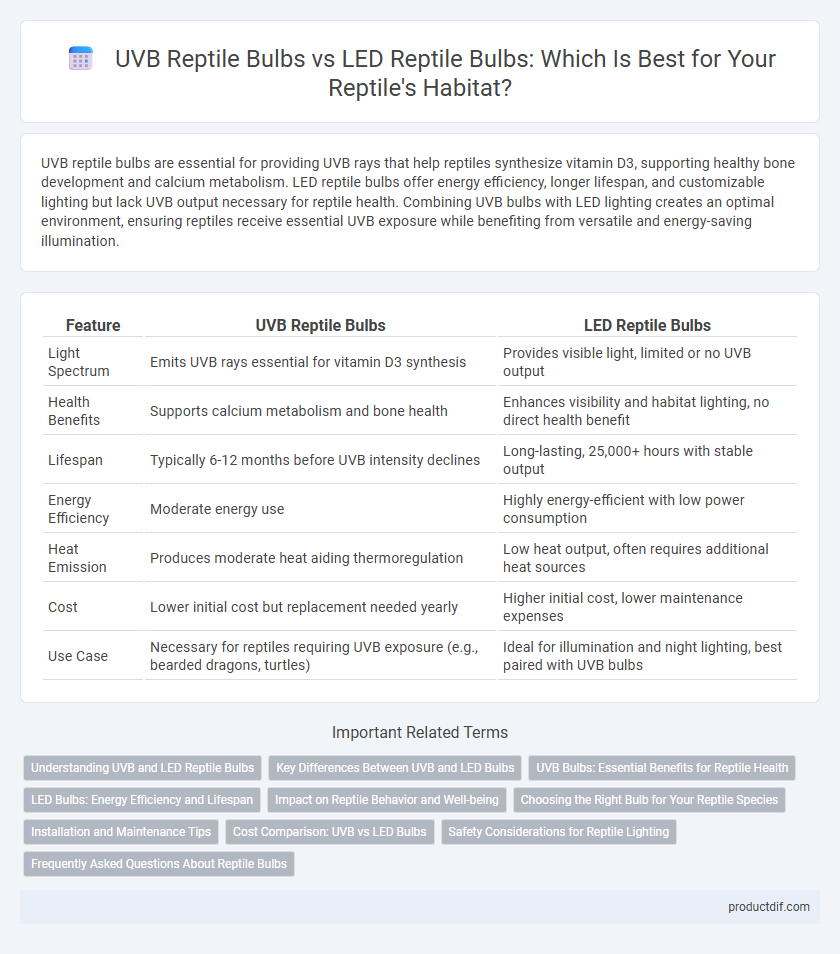UVB reptile bulbs are essential for providing UVB rays that help reptiles synthesize vitamin D3, supporting healthy bone development and calcium metabolism. LED reptile bulbs offer energy efficiency, longer lifespan, and customizable lighting but lack UVB output necessary for reptile health. Combining UVB bulbs with LED lighting creates an optimal environment, ensuring reptiles receive essential UVB exposure while benefiting from versatile and energy-saving illumination.
Table of Comparison
| Feature | UVB Reptile Bulbs | LED Reptile Bulbs |
|---|---|---|
| Light Spectrum | Emits UVB rays essential for vitamin D3 synthesis | Provides visible light, limited or no UVB output |
| Health Benefits | Supports calcium metabolism and bone health | Enhances visibility and habitat lighting, no direct health benefit |
| Lifespan | Typically 6-12 months before UVB intensity declines | Long-lasting, 25,000+ hours with stable output |
| Energy Efficiency | Moderate energy use | Highly energy-efficient with low power consumption |
| Heat Emission | Produces moderate heat aiding thermoregulation | Low heat output, often requires additional heat sources |
| Cost | Lower initial cost but replacement needed yearly | Higher initial cost, lower maintenance expenses |
| Use Case | Necessary for reptiles requiring UVB exposure (e.g., bearded dragons, turtles) | Ideal for illumination and night lighting, best paired with UVB bulbs |
Understanding UVB and LED Reptile Bulbs
UVB reptile bulbs emit ultraviolet B rays essential for reptiles to synthesize vitamin D3, aiding calcium absorption and preventing metabolic bone disease. LED reptile bulbs offer energy-efficient illumination with customizable spectra but typically lack UVB output, requiring supplementary UVB sources for optimal reptile health. Selecting bulbs that balance UVB exposure and visible light enhances reptile well-being and mimics natural sunlight conditions.
Key Differences Between UVB and LED Bulbs
UVB reptile bulbs emit ultraviolet B rays essential for reptiles' vitamin D3 synthesis, supporting calcium metabolism and preventing metabolic bone disease. LED reptile bulbs provide bright, energy-efficient visible light without UVB radiation, enhancing enclosure lighting but not fulfilling reptiles' specific UVB needs. Choosing between them depends on balancing the biological benefits of UVB exposure with the longevity and brightness advantages of LED technology.
UVB Bulbs: Essential Benefits for Reptile Health
UVB reptile bulbs emit essential ultraviolet B rays that support reptiles' calcium metabolism and promote healthy bone growth, preventing metabolic bone disease. Unlike LED reptile bulbs, which focus mainly on visible light and heat, UVB bulbs replicate natural sunlight necessary for vitamin D3 synthesis. Consistent exposure to UVB lighting is critical for maintaining overall reptile health, immune function, and proper behavioral patterns.
LED Bulbs: Energy Efficiency and Lifespan
LED reptile bulbs offer superior energy efficiency compared to UVB bulbs, consuming significantly less power while providing consistent lighting essential for reptile health. The extended lifespan of LED bulbs, often exceeding 25,000 hours, reduces replacement frequency, lowering long-term maintenance costs. Energy-efficient LED technology also produces less heat, minimizing the risk of overheating in terrariums and promoting a stable habitat environment.
Impact on Reptile Behavior and Well-being
UVB reptile bulbs play a crucial role in promoting natural behavior and overall well-being by enabling reptiles to synthesize vitamin D3, essential for calcium metabolism and bone health. In contrast, LED reptile bulbs primarily provide visible light without UVB radiation, potentially leading to deficient calcium absorption and behavioral issues such as lethargy or malnutrition. Optimal reptile care involves incorporating UVB lighting to support physiological needs and encourage active, healthy behaviors.
Choosing the Right Bulb for Your Reptile Species
UVB reptile bulbs are essential for species requiring calcium metabolism and vitamin D3 synthesis, such as bearded dragons and iguanas, while LED reptile bulbs provide energy-efficient lighting without UVB output, suitable for species that do not depend on UVB exposure. Selecting the appropriate bulb depends on your reptile's natural habitat and specific UVB needs, with UVB bulbs offering critical health benefits but requiring periodic replacement to maintain effectiveness. LED bulbs offer longevity and lower heat emission, making them ideal for species needing consistent visible light but minimal heat and UV exposure.
Installation and Maintenance Tips
UVB reptile bulbs require secure fixture installation with proper distance to ensure effective UVB exposure while preventing overheating, and they typically need replacement every 6 to 12 months to maintain UV output. LED reptile bulbs offer easier installation due to lower heat output and longer lifespan, often exceeding 25,000 hours, which reduces replacement frequency and maintenance effort. Regular cleaning of reflectors and fixtures is essential for both bulb types to maximize light intensity and ensure optimal reptile health.
Cost Comparison: UVB vs LED Bulbs
UVB reptile bulbs generally have a lower upfront cost but require more frequent replacement, increasing long-term expenses. LED reptile bulbs, while more expensive initially, offer greater energy efficiency and durability, reducing overall maintenance costs. Evaluating both options, LED bulbs often present better value despite higher initial investment due to longevity and energy savings.
Safety Considerations for Reptile Lighting
UVB reptile bulbs emit essential ultraviolet light that supports reptiles' calcium metabolism and bone health, but improper use can cause overheating or eye damage, necessitating safe placement and regular monitoring. LED reptile bulbs offer energy-efficient lighting with minimal heat emission, reducing burn risks and improving enclosure temperature control. Ensuring bulbs have appropriate UVB output and avoiding direct exposure to eyes are critical safety measures for reptile lighting.
Frequently Asked Questions About Reptile Bulbs
UVB reptile bulbs emit essential ultraviolet B rays that promote calcium absorption and prevent metabolic bone disease in reptiles, unlike LED reptile bulbs which primarily provide visible light without UVB benefits. Reptile owners often ask how frequently UVB bulbs should be replaced, with manufacturers recommending every 6 to 12 months as UVB output diminishes even if the bulb still emits visible light. Questions also arise about heat provision, where UVB bulbs typically produce necessary basking heat, whereas LED bulbs may require separate heating elements to maintain appropriate habitat temperatures.
UVB reptile bulbs vs LED reptile bulbs Infographic

 productdif.com
productdif.com